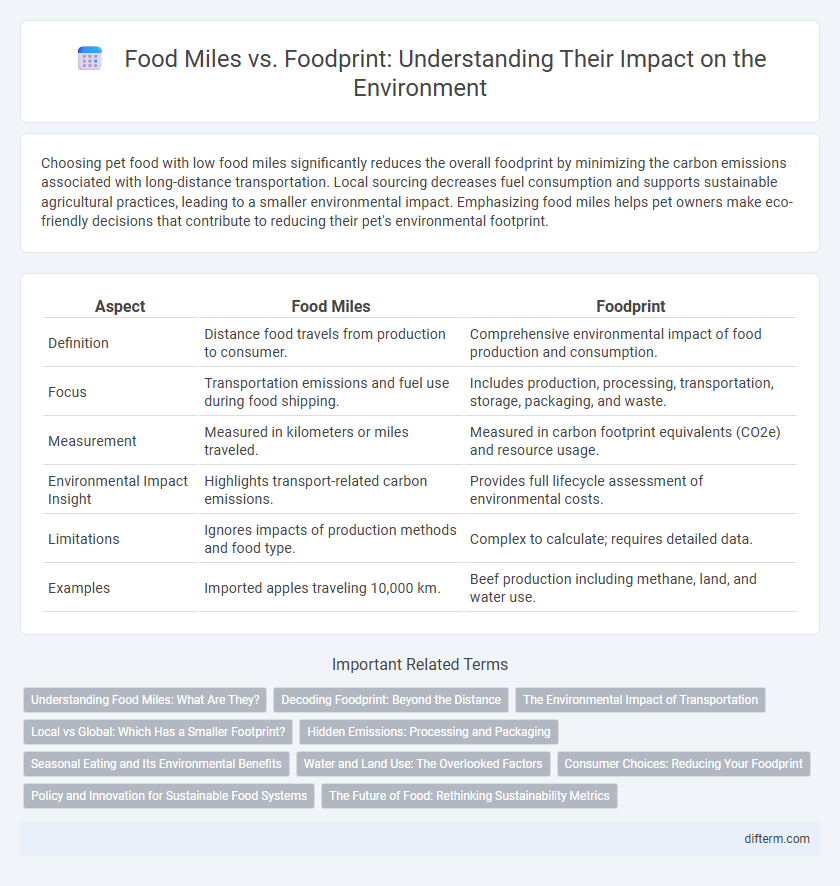Choosing pet food with low food miles significantly reduces the overall foodprint by minimizing the carbon emissions associated with long-distance transportation. Local sourcing decreases fuel consumption and supports sustainable agricultural practices, leading to a smaller environmental impact. Emphasizing food miles helps pet owners make eco-friendly decisions that contribute to reducing their pet's environmental footprint.
Table of Comparison
| Aspect | Food Miles | Foodprint |
|---|---|---|
| Definition | Distance food travels from production to consumer. | Comprehensive environmental impact of food production and consumption. |
| Focus | Transportation emissions and fuel use during food shipping. | Includes production, processing, transportation, storage, packaging, and waste. |
| Measurement | Measured in kilometers or miles traveled. | Measured in carbon footprint equivalents (CO2e) and resource usage. |
| Environmental Impact Insight | Highlights transport-related carbon emissions. | Provides full lifecycle assessment of environmental costs. |
| Limitations | Ignores impacts of production methods and food type. | Complex to calculate; requires detailed data. |
| Examples | Imported apples traveling 10,000 km. | Beef production including methane, land, and water use. |
Understanding Food Miles: What Are They?
Food miles measure the distance food travels from production to consumption, directly influencing greenhouse gas emissions and overall environmental impact. Understanding food miles helps assess the carbon footprint associated with transportation, highlighting the importance of local sourcing to reduce energy use and pollution. Comparing food miles with the broader concept of foodprint emphasizes that production methods and packaging also significantly affect the sustainability of food systems.
Decoding Foodprint: Beyond the Distance
Foodprint measures the total environmental impact of food production, including greenhouse gas emissions, water use, and land degradation, offering a holistic view beyond just transportation distances represented by food miles. Understanding foodprint helps prioritize sustainable choices by emphasizing factors like farming practices, supply chain efficiency, and seasonal consumption. Reducing foodprint requires integrated strategies that address resource use throughout the entire food system, not just minimizing the miles food travels.
The Environmental Impact of Transportation
Food miles measure the distance food travels from production to consumer, highlighting transportation-related emissions that contribute significantly to the carbon footprint. Transportation methods, such as air freight, trucks, and ships, vary in fuel efficiency and greenhouse gas emissions, with air freight having the highest environmental impact per kilometer. Reducing food miles by sourcing locally can lower transportation emissions, but comprehensive foodprint analysis also considers factors like production, packaging, and storage to fully assess environmental sustainability.
Local vs Global: Which Has a Smaller Footprint?
Local food typically has a smaller carbon footprint than globally sourced food due to reduced transportation emissions, known as food miles, which can account for up to 11% of total food-related greenhouse gas emissions. However, the overall foodprint also depends on production methods, with some locally produced foods requiring more energy-intensive practices than efficient global supply chains. Evaluating environmental impact requires assessing both food miles and production efficiency to determine whether local or global food options minimize the total carbon footprint.
Hidden Emissions: Processing and Packaging
Food miles measure the distance food travels from production to consumption, often overlooking hidden emissions generated during processing and packaging stages. These hidden emissions contribute significantly to the overall foodprint by consuming energy-intensive resources and releasing greenhouse gases in factories and packaging plants. Reducing foodprint requires addressing energy use, material waste, and carbon output beyond transport distance to achieve comprehensive environmental impact reduction.
Seasonal Eating and Its Environmental Benefits
Seasonal eating significantly reduces food miles by encouraging consumption of locally grown produce, which minimizes transportation emissions and lowers overall carbon footprint. This practice promotes sustainable agriculture by aligning food consumption with natural growing cycles, reducing the need for energy-intensive storage and preservation methods. Embracing seasonal foods enhances environmental benefits by supporting biodiversity, conserving resources, and mitigating the ecological impact associated with out-of-season imports.
Water and Land Use: The Overlooked Factors
Food miles measure the distance food travels, but water and land use significantly impact the environmental footprint, often overlooked in sustainability assessments. Producing animal-based foods typically requires greater water and land resources compared to plant-based options, contributing extensively to water scarcity and habitat loss. Evaluating foodprint by incorporating these factors offers a more comprehensive understanding of sustainable food production and consumption.
Consumer Choices: Reducing Your Foodprint
Choosing locally sourced foods significantly reduces food miles, lowering carbon emissions associated with transportation. Consumers can minimize their foodprint by prioritizing seasonal and minimally processed products, thereby lessening energy consumption throughout the supply chain. Embracing plant-based diets further decreases environmental impact, emphasizing sustainable consumption patterns that protect natural resources.
Policy and Innovation for Sustainable Food Systems
Policy frameworks promoting local food production reduce food miles and carbon footprints by incentivizing sustainable agricultural practices and supply chain optimization. Innovations such as blockchain enhance transparency in tracking food origins and emissions, enabling more accurate foodprint assessments and informed consumer choices. Collaboration between governments, startups, and research institutions accelerates the deployment of eco-friendly technologies, fostering resilient and low-impact food systems.
The Future of Food: Rethinking Sustainability Metrics
Food miles measure the distance food travels from production to consumer, but foodprint evaluates the total environmental impact, including carbon emissions, water usage, and land degradation. Shifting towards foodprint analysis promotes sustainable practices by encouraging local sourcing, seasonal eating, and minimizing resource-intensive foods. Emerging technologies and data analytics enable more accurate foodprint assessments, guiding consumers and producers to reduce the ecological footprint of food systems.
food miles vs foodprint Infographic

 difterm.com
difterm.com